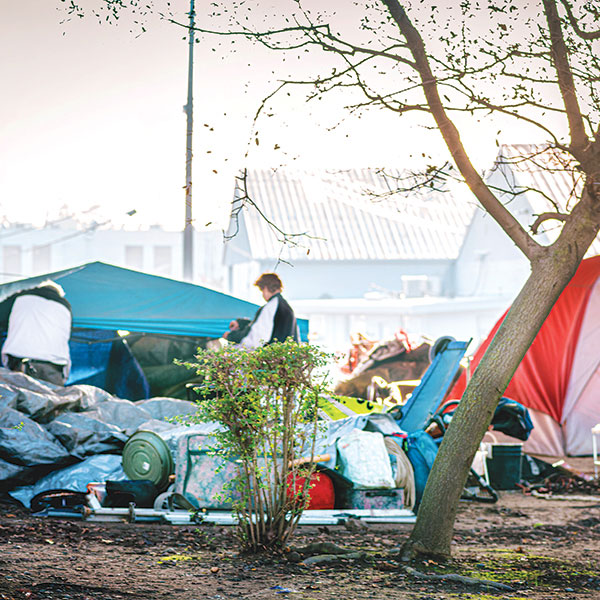In May 2019, I wrote my first article on the tragedy of homeless people living on our streets. The column was titled “Is Sacramento Dying?” It was based on the documentary film “Seattle Is Dying.”
The film was produced by Seattle TV station KOMO in 2018. It begins with a bold thesis: This is about an idea. For a city that has run out of them. What if Seattle is dying? Can it ever recover?
The column was the most widely shared article on our website—shared thousands of times. Many readers feared our city was following Seattle’s course, driven by a lack of civic leadership.
The response helped me recognize the inadequacy of Sacramento media coverage. Homeless problems were not being seriously discussed in 2019. At Inside, we vowed to publish news, viewpoints, ideas and solutions in every issue moving forward.

To better understand why our streets were becoming crowded with tents and people living in vehicles, I read about the causes of homelessness and why current solutions fail to help and often make things worse.
I spoke to elected officials and civic leaders. Sadly, I discovered the folly of some closed-minded elected officials and well-funded nonprofit executives. They were determined to follow the same path that devastated other communities.
Some of my questions: Why do people become homeless? Which interventions can prevent or resolve the problem? What strategies can address long-term, underlying causes? How do we protect neighborhoods and businesses?
I learned the homeless population is heterogeneous. The easiest to help are the economically homeless—people evicted after losing jobs or family support. The hardest to help are drug addicts and people suffering mental health crises, often the result of drug use.
Biennial efforts to count the local homeless population make it clear the numbers have exploded over the past decade, with no end in sight. As numbers increase, so do complexities.
Some experts believe terminology can help clarify specific types of homelessness. People can experience homelessness, but they are considered “sheltered” if they live in homeless shelters or transitional housing.
I’ve noticed a shift in language, especially among progressives and advocates. Homeless people are called “the unhoused” or “persons without homes.” City Council member Katie Valenzuela recently referred to homeless people as her “unhoused constituents and neighbors.”
In Western Europe, the word “homeless” is rarely used. Instead, people who live rough are called “street addicts.” Their encampments are “open-air drug scenes.” This is important to note because Western Europe has been more successful in reducing its homeless problem than U.S. Pacific Coast cities.
I recently read “San Fransicko: Why Progressives Ruin Cities” by Michael Shellenberger. It should be required reading for anyone who cares about identifying the problems and finding real solutions. Shellenberger recently announced his decision to run for governor against Gavin Newsom.
Shellenberger skewers progressives for mishandling the crisis. “Progressives claimed they knew how to solve homelessness, inequality and crime. But in cities they control, progressives made those problems worse,” he said in a recent podcast.
Shellenberger—a Bay Area resident for 30 years—has progressive roots. He advocated for the decriminalization of drugs, affordable housing, and alternatives to jail and prison. But as homeless encampments spread and overdose deaths skyrocketed, he decided to look deeply into the problem.
He was shocked by what he discovered. “The problems had grown worse not despite but because of progressive policies,” he says. He explains how San Francisco and other West Coast cities—Los Angeles, Seattle and Portland—went beyond tolerating homelessness, drug dealing and crime to actively enabling them.
The book reveals the underlying problem isn’t a lack of housing or money for social programs. “The real problem is an ideology that designates some people, by identity or experience, as victims entitled to destructive behaviors,” he says. “The result is an undermining of the values that make cities, and civilization itself, possible.”
Shellenberger cites what he calls San Francisco’s “pathological altruism.” For example, the city spent $61,000 per tent for homeless campers. Such spending, combined with the “sacralization of victims” and abandonment of equal treatment under law, has been a disaster.
“Progressive victimology preaches these behaviors that are destructive of individuals and urban civilization are definitionally caused by ‘systemic’ this or that—racism, oppression, etc. So, progressivism strips victims of agency but also defines them as ‘inherently good’ because they have been victimized,” he says.
Shellenberger’s book details many facets of homelessness. They range from drug addiction, the failure of “Housing First” strategies, mental illness, crime, recovery, funding and leadership. He includes interviews with street people and city and nonprofit leaders. He describes a path forward. It’s something very different from what West Coast cities—Sacramento included—have done.
In future months, I’ll examine the important issues Shellenberger raises about our city. And we will continue to bring Inside Sacramento readers the most comprehensive coverage of the homeless crisis.
To read “Is Sacramento Dying?” from May 2019, visit insidesacramento.com/is-sacramento-dying. All of our homeless articles and videos are available to read and share at insidesacramento.com/columns/insidehomelessness. Cecily Hastings can be reached at publisher@insidepublications.com. Follow us on Facebook and Instagram: @insidesacramento.















